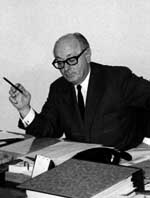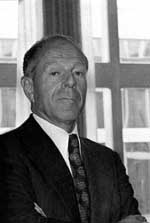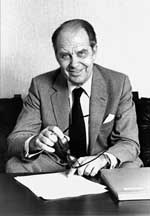| ISO 9000 | ISO 14000 | Forum |

| The book Friendship
Among Equals (1997) is based on the recollections of seven
people who have worked for ISO over the last 50 years. Each of
the reminiscences is preceded by an introduction which gives background
information about the topics covered.
Below you can read extracts from each section of the book, and download the section if you choose. Friendship Among Equals was researched and written by Jack Latimer.
|
|
In the Foreword
Lawrence Eicher, the former ISO Secretary-General, gives his own
personal perspective on ISO's last ten years and explains the
origin of the book:
"I believe that the essence of ISO's history is made up of the visions, aspirations, doubts, successes and failures of the people who, over the past fifty years, have created this rather remarkable organization...So, let me put on Larry Eicher's hat and express a few personal thoughts about why I love my job..."
|
"Things are going the right way!" |
This section
of the book covers the 1946 London conference at which ISO was
established. Willy Kuert is now the only surviving delegate:
"We went to London, we Swiss, hoping to create a new organization which would do the work of standardization in a democratic way, and not cost too much money. At the end of the London conference, we had the feeling that the new statutes and new rules would permit us to do such work. Real, effective work." Things are going the right way!" That was the feeling...
|
"We had some good times" |
Roger
Marйchal was formerly the Assistant Secretary-General of ISO.
This section of the book describes the early and turbulent years
of ISO, during which Roger Marйchal's loyal and steadfast service
helped to hold the Central Secretariat together.
"At the beginning, we still used stencils for reproduction. We were sending maybe 10 copies of a document, but it was quite a business, you know ! I remember, even when we were free on Saturday mornings, we were requested to work to finish the dispatches to member bodies. (At that time, there were 34 member bodies, something like that.) We were all involved, even the engineers...But, in fact, at that time we had the feeling that we were participating in an important activity. I think each one was supposed to bring his own stone with him, you know, to help to build the house..."
|
"A phenomenal success story" |
This
section of the book celebrates the standard-setting achievements
of ISO's Technical Committees. Vince Grey, former Chairman and
Secretary of ISO/TC 104, tells the success story of the standardization
of freight containers.
"There are certain standards that are essential to describe a freight container, and it wasn't until the Moscow meeting in 1967 that someone could really go out in the manufacturing field and say: "I want an ISO container." Anyhow, once that last peg was put in place...the industry just took off !... The whole committee had the sat be isfaction of a job well done. We achieved our wildest dreams!"
|

"The global view" |
Raymond
Frontard was the Director of AFNOR, and one of ISO's inspirational
leaders during the expansion of its activities in the 1960s and
1970s. This section of the book traces the history of issues in
standardization such as consumer policy, conformity assessment,
standardization in developing countries, and the development of
the ISONET information network.
"We were faced with a global problem of information management. Standardization has become an information phenomenon, generating hundreds of thousands of publications - perhaps a million by now ! Each of these publications has exceptional technical and economic influence in its field and geographic area, and can tip a significant share of the market one way or another. At its current rate, the documentation doubles every eight years. All technical information is in the same boat...This amounts to a process of self-suffocation...Standardization, however, can avoid this curse..." Download Standards-Related Activities
|
"Decade by decade" |
From
1968 to 1986, Secretary-General Olle Sturen guided ISO's expansion
and growth in international importance. His recollections give
a unique perspective on four decades of ISO's history.
"When I left as ISO Secretary-General in 1986, I had forty years of standards activity (national and international) behind me; forty years which coincided with the first four decades of ISO operation. On the basis of my involvement with ISO over the years, I would divide the period 1947-1986 into four parts, decade by decade. The first part was the establishment of ISO; the second, discontent and turmoil; the third: rebuilding confidence; and the fourth, enjoying the fruit of our efforts..."
|
"Pretty darn quick" |
ISO's
recent history presents new challenges. Anders J. Thor, our current
champion of the metric system, describes his part in the laborious
process of keeping ISO's ever-expanding catalogue of standards
up to date.
"When I took over the Secretariat in 1982, we started to discuss the 5-year review of the oldest standards. Olle Sturen was the Secretary General, and I remember I visited him in Geneva, and had a talk with him about the revision of ISO 31. He inspired me to prepare all the parts so they could be issued and voted on at the same time....At the General Assembly in Madrid in the autumn of 1991, people came up to me and said that the President of ISO had mentioned me in his speech..."Pretty darn quick! That was his expression...I thought it had taken a very long time!"
|

"I've got the virus!" |
Roseline
Barchietto came to work at ISO in Geneva as a young girl forty
years ago, became fasinated by standardization, and is now our
longest serving employee. The final section of Friendship Among
Equals traces the development of the Central Secretariat.
"We have always improved. We were always at the very top. When new tools became available, they were very soon placed at our disposal. The telex was introduced very quickly, and things became more urgent. When you have a letter which takes 15 days to arrive, you think: "Well, it can wait. I will do it in a few days! "But when you have a telex, you feel obliged to answer immediately. You get to know the meaning of stress.." Download
|
|
|








